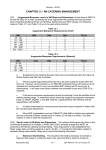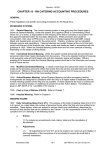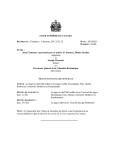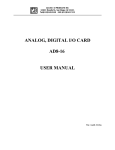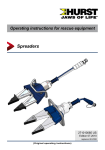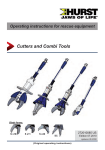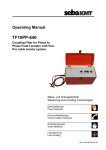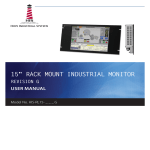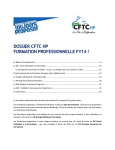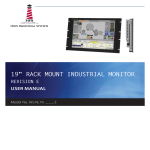Download Leaflet 06 - Electricity and Electrical Equipment
Transcript
BFG SHEF MANUAL - PART 2 – LEAFLET 6 Leaflet 6 - Electricity and Electrical Equipment Table of Contents REVISION SUMMARY ......................................................................................................................... 1 REFERENCES: ................................................................................................................................. 1 INTRODUCTION ................................................................................................................................ 2 DEFINITION ...................................................................................................................................... 2 DUTIES............................................................................................................................................ 2 Commanding Officers ......................................................................................................... 2 Line managers .................................................................................................................... 2 Employees........................................................................................................................... 2 GUIDANCE FOR LINE MANAGERS ...................................................................................................... 2 WORKING ON ELECTRICAL INSTALLATIONS AND ELECTRICAL EQUIPMENT ........................................... 2 MAINTENANCE OF OFFICE EQUIPMENT .............................................................................................. 3 MAINTENANCE OF PORTABLE ELECTRICAL APPLIANCES ..................................................................... 3 EXTENSION LEADS ........................................................................................................................... 3 MULTI-PLUG ADAPTORS ................................................................................................................... 3 3 PIN (UK) TO 2 PIN (GERMAN) PLUG ELECTRICAL MAINS ADAPTORS ................................................... 3 USE OF PERSONAL ELECTRICAL EQUIPMENT ...................................................................................... 4 ELECTRICAL TESTING....................................................................................................................... 5 DII(F) COMPUTER EQUIPMENT .......................................................................................................... 6 HIGH VOLTAGE CABLES ................................................................................................................... 7 RAILWAY FLATS HAZARD.................................................................................................................. 7 COMPLIANCE WITH MANUFACTURERS OPERATING INSTRUCTIONS ...................................................... 7 RECORDS ........................................................................................................................................ 7 Annex A - Inspection Intervals for Portable Equipment ...................................................... 8 Revision summary The only authoritative version is that published on the HQ BFG SHEF Website. All other copies, printed or electronic, are defined as uncontrolled. Changed information since the last revision is shown in blue text below and is hyperlinked. Previous revisions are then incorporated in black text but remain indicated on the record below until overwritten by subsequent amendment. Minor editorial and syntax changes, hyperlink repair as well as any deletions are not shown unless clarity so requires. Comments or suggestions for amendment are to be submitted to SO1 SHEF HQ BFG. Subject (Ctrl+click) Compliance with manufacturers operating instructions Use of personal electrical equipment 3 pin (UK to 2 pin (German) plug adaptors (to be repeated periodically in Unit orders) UKSC or GSG changed to BFG G3 Ops Sp removed Para 18 - adapters & para 37 DIIF Annual review Amended to reflect changes to JSP 375 in line with CESO(A) ltr CESO(A)/02.2 dtd 18 Aug 15. References: A. B. C. E. JSP 375, Part 2, Volume 1, Chapter 23. Unfallverhütungsvorschrift DGUV 3 für Elektrische Anlagen und Betriebsmittel. New Norm (Standard) VDE 0702. CESO(A)/02.2 dtd 18 Aug 15 Revision date 31 Aug 15 Part 2 – Leaflet 6 Page 1 of 8 Revision date 8 Jul 10 13 Oct 10 3 Mar 13 2 Mar 12 13 May 14 27 Nov 14 2 Jul 15 31 Aug 15 BFG SHEF MANUAL - PART 2 – LEAFLET 6 Introduction 1. Electricity, when properly controlled and used, is a safe and efficient form of energy. However if electricity is misused it can be dangerous causing serious harm to people and equipment. Consequently, those who work with or manage electrical installations and/or equipment shall comply with the stringent requirements of References A and B. Definition 2. A portable electrical appliance is any item of equipment that is not part of a fixed installation, but is intended to be connected to a fixed installation, or generator, by means of a flexible cable and either a plug and socket, or a spur box, or similar means. 3. Portable appliances can be divided in to 2 categories - Static equipment and portable equipment. These categories are as follows: a. Static equipment includes: computers, printers, water dispensers, photocopiers, vending machines, fax machines, etc. This equipment is not normally moved about, but as it is connected to the mains via a plug and socket, it can be relocated as required. b. Portable equipment includes: kettles, hand drills, vacuum cleaners, fans etc. This equipment is frequently connected to and disconnected from the mains circuit. 4. Excluded from this Chapter is fixed electrical equipment already maintained in accordance with an approved formal scheduled procedure (i.e. DIO Safety Rules and Procedures). Employees working with this equipment will comply with formal safe systems of work. Duties Commanding Officers 5. Commanding Officers are to ensure that their unit has adequate arrangements for the effective management of the risk associated with electricity in the workplace. These arrangements are to be monitored and reviewed accordingly. Line managers 6. Line managers are to ensure that all persons are protected from the hazards associated with the use of electrical equipment within their workplace. The main hazards are electrocution, burns, fire, explosion and indirect injuries such as falls from height when in contact with electricity. Employees 7. Employees are to check that prior to use the electrical equipment appears to be in a serviceable condition, and report any faults with the equipment or system to the line manager. They are to comply with the appropriate risk assessment and formal safe systems of work. Guidance for Line Managers 8. Line managers must ensure that where a risk of injury is foreseeable then employees receive adequate training and information that allows them to use or work safely on electrical equipment or systems. 9. Advice must be sought from the USA where DEL and military employees interface and electrical equipment is subject to inspection and maintenance by a competent person. Working on Electrical Installations and Electrical Equipment 10. No work is to be carried out to any electrical installation or fixed equipment regardless whether live or completely isolated and/or disconnected without the express consent of the appropriate authority (ie. DE(E)). Only authorised, trained, experienced and competent personnel are allowed to work on electrical installations and fixed equipment. This must also be in accordance with the safe system of work, which may include a permit to work system. Reference A provides further guidance. Revision date 31 Aug 15 Part 2 – Leaflet 6 Page 2 of 8 BFG SHEF MANUAL - PART 2 – LEAFLET 6 11. In accordance with References B & C it is not permitted to carry out any unauthorised alterations or modifications to any portable electrical equipment (eg. cutting off a sealed plug and replacing with a nonsealed one or removing plug and cable complete from the body of the equipment and replacing) unless done by a fully qualified and competent electrician. Carrying out such work may invalidate any manufacturer’s guarantees and the competent electrician may be liable should any related malfunction occur. Maintenance of Office Equipment 12. Office staff with the minimum of training and supervision can generally carry out simple maintenance (changing cartridges, dealing with paper jams etc) on general office equipment such as photocopiers, computers and printers. Where guards or other safety devices have to be removed or disconnected then only a competent person is to carry out the maintenance. Care should be taken however, when changing overhead light bulbs that may require the use of ladder/steps, where the additional hazard of working at height must also be considered. Maintenance of Portable Electrical Appliances 13. All portable electrical appliances are to be maintained to prevent danger to employees and others. This implies that best practice is that all equipment has to be identified, marked with a unique number and entered into an electrical equipment register. It then has to be subject to a maintenance regime based on the equipment held, the circumstances of its use and the potential related risk. 14. There is little difference between Host Nation legislation and its UK equivalent in defining who is competent to carry out electrical maintenance. Each also provides a table of maintenance periodicity and allows maintenance periods to be extended depending on satisfactory maintenance results. 15. Formal maintenance of electrical appliances is to be carried out by a competent person. However the line manager can reduce risk by implementing a simple system of visual inspection by the user before and after use to identify obvious physical damage to the appliance and associated electrical system. Reference A provides detailed guidance. Extension leads 16. Extension leads are classed as portable electrical appliances and shall be inspected, tested and maintained accordingly. These are used widely throughout BFG as a means to increase the number of socket outlets and/or provide an electrical supply to an area away from the socket outlet. Care must be taken to ensure that the current drawn by attached appliances never reaches the maximum permitted load for the lead or the socket and that cables do not create a fall or trip hazard. Leads must never be used in a coiled position as this increases the risk of overheating and fire. The use of extension leads is discouraged and should only be considered as a temporary measure for short-term use. In the long term, in so far as is reasonably practicable, arrangements should be made to have fixed socket outlets fitted within buildings/facilities. 17. Under no circumstances shall extension leads be added together to extend distance between equipment and the socket outlet. Multi-plug Adaptors 18. These are adapters which are plugged directly into the power outlet (without an extension cable) and have sockets to allow 3 or more items of electrical eqpt to be plugged into a single outlet. Use of these adaptors in the workplace is prohibited at all times. 3 pin (UK) to 2 pin (German) plug electrical mains adaptors (to be repeated periodically in Unit orders) 17. It is common practice for UK based personnel to use electrical plug mains adaptors to enable a 3 pin UK appliance to be plugged into a German 2 pin socket, normally to avoid cutting off a useable plug and perhaps invalidating the warranty. However, not all such adaptors are actually fit for purpose or use with all appliances. i.e their power rating is too low. Revision date 31 Aug 15 Part 2 – Leaflet 6 Page 3 of 8 BFG SHEF MANUAL - PART 2 – LEAFLET 6 18. To meet the duty of care, it is BFG policy that all electrical adaptors used within the workplace or within residential accommodation must be fit for purpose and safe to use. UK 3 pin to German 2 pin adaptors connected to appliances that have a high amperage rating; for example, kettles, washing machines, dishwashers and tumble dryers must therefore at least be clearly marked 1 ’13 Amp’ (this equates to a max of 3 Kw at 230V) and be earthed on both sides. Such adaptors, which are available from all main NAAFI shops, can normally also be used for most types of household appliances unless otherwise stated in the manufacturers instructions. Adaptors which do not show the amperage are not to be used in any circumstances. It is best practice to have all adaptors showing ratings and rated as described above, thus allowing flexibility of use and reducing risk. 19. Appliances which require high amperage, or which must be earthed, whether using an adaptor or not, must be plugged into their own wall socket and never into a multi-socket extension lead. They must not be connected to adaptors that can take two UK 3 pins plugs as this can overload the socket. 20. Travel adaptors, such as those for multi-country use, are not suitable for appliances that require an earth connection and, as the name implies, are really for travel use. They may only be used with double insulated appliances; these will be marked with a symbol . Therefore appliances that require an earth connection or high amperage should be connected to the mains by use of an appropriately marked and earthed adaptor. The MOD supplied multi-pin travel adapter NSN Z32 5935 99 147 2536 is only to be used for travelling purposes and not for permanent use. 21. The use of an adaptor that is of sub standard or inferior quality may overheat causing injury or damage to the appliance, the wall sockets and electrical circuits and possibly in worse case a fire. 22. The use of inappropriate adaptors in barracks or in single living accommodation is not permitted. Any such adapters must be permanently taken out of use and the socket used visually checked for damage, which must be reported. Damaged sockets must not be used until professionally repaired and declared safe to use. 23. If there are any concerns about electrical safety at your place of work or in your accommodation then this is to be reported immediately in accordance with local instructions. 24. Legal advice is that occupants of MoD accommodation (be it in the workplace or at home) will be liable to the MOD for the cost of repairing any damage caused by improper or inappropriate use, including use contrary to the guidance set out in this leaflet of electrical adaptors used by the occupants within the accommodation. The MoD will also seek to recover from such occupants all costs, claims, expenses and damages incurred as a result of claims by third parties alleging injury or damage caused by the improper or inappropriate use of adaptors. Use of personal electrical equipment The use of personal items of electrical equipment in the workplace is discouraged as their suitability for use and standard of inspection, maintenance and repair cannot be easily guaranteed. 25. 26. Reference A states that ultimately the decision to allow personal portable electrical equipment and appliances to be used on the Defence establishment (including clubs etc.) rests with the CO/HoE. If this occurs within Army TLB, then a local policy/procedure should be developed and promulgated to all personnel which defines where the use of personal electrical equipment/appliances is allowed, and the control measures (i.e. test and inspection) to be adhered to. The local policy/procedure should define what is and what is not covered in the scope of personal electrical equipment and any restrictions on their use. 1 Note that regulations do not require mains plugs or socket outlets for domestic use to be marked with CE (exempt through the Low Voltage Directive 2006/95/EC ), VDE or BS standards. Revision date 31 Aug 15 Part 2 – Leaflet 6 Page 4 of 8 BFG SHEF MANUAL - PART 2 – LEAFLET 6 27. There are areas such as accommodation areas for service personnel where it is impossible to instigate a full inspection and testing regime. A risk assessment must be carried out and suitable and sufficient control measures put in place. 28. Possible control measures may include: a. Permission required for items of electrical equipment. b. Visual checks made of equipment on a regular basis. c. Removal of unsafe equipment. Electrical Testing 29. Reference A lays down the policy to be applied including the formal testing of electrical equipment. This must be undertaken by a competent person (having the required knowledge, training and experience). For the Army this means that those conducting PAT must have undergone some form of PAT training either arranged via CESO(A) / Regional Comd or through appropriate trade training. 30. When formulating the local policy/procedure, the following must be appreciated: In the UK there is no requirement to test privately owned electrical equipment used within SLAM unless it is not for the sole use of the owner of the equipment. To this end, all occupants that use communal areas (e.g. kitchens) are to be reminded that any personal electrical equipment is to be kept in their own private rooms/lockers and not in communal areas. Electrical equipment in communal areas that has been provided by the employer is to be subjected to PAT. 31. Where applicable, for overseas establishments, local procedures should, where appropriate, include the use of adaptors for electrical equipment with different plugs or voltages to the host nation domestic electrical system. 32. Electrical testing using portable appliance testers (PAT) where the interpretation of the read out requires electrical knowledge is only to be carried out by a competent person. Host Nation legislation and standards shown at References B & C, differ from the UK equivalent in that it states “inspections/testing must be carried out by qualified electricians or, where the correct test equipment is used, with, for instance, a good-bad” signal, they may be carried out by persons instructed in electro-techniques under the guidance and supervision of qualified electricians”. 33. However, the German Accident Insurers (Unfallversicherung Bund und Bahn - UVB) have made the following interpretation: “so long as the ‘competent person’ has been trained by a fully qualified electrician on the operation procedure of the PAT, there is no restriction in allowing that person to work independently”. The term “under the guidance and supervision” basically means that the qualified electrician needs to be fully satisfied that the individual is competent to carry out the testing required and to check that they are carrying out the work to a satisfactory standard. There is no intention to ensure the person is constantly monitored or shadowed during the inspections/testing of the equipment. 34. The qualified electrician conducting the training can be Military, UKBC DEL or DEP but consideration needs to be given to ensure there are no language difficulties that may affect understanding of the instructions. 35. This interpretation effectively differs from the UK requirement in that the operator receives training on the use of the equipment by a person deemed “competent” to provide it but that person does not need to be a qualified electrician. They must however, supervise the operator until they are satisfied that they are fully competent. The definition of competence is described clearly at Part 2, Leaflet 3 of this Manual. For Military, UKBC or DEP pers, PAT testing instruction may in exceptional circumstances be provided under the authority of SHEF, HQ BFG by a MoD civilian contractor 36. Based on the above guidance, the following procedure should be followed: Revision date 31 Aug 15 Part 2 – Leaflet 6 Page 5 of 8 BFG SHEF MANUAL - PART 2 – LEAFLET 6 a. Only qualified electricians must be allowed to train DEL personnel on how to carry out PAT in the workplace. b. Qualified electricians are also permitted to train Military personnel, UKBCs and DEPs on how to carry out PAT in the workplace. Note: qualified electricians can be DEL, Military, DEP or UKBC. See paragraph 33 above. c. UK “competent” persons (not qualified electricians) are NOT permitted to train DEL on how to carry out PAT in the workplace. d. UK “competent” personnel (not qualified electricians) ARE permitted to train Military personnel, UKBCs and DEPs on how to carry out PAT in the workplace. 37. NATO SOFA SA §56(3) states: “Accident prevention regulations under German law shall be taken into account only to the extent that a force or civilian component has not issued corresponding accident prevention directives” As far as BFG is concerned this is the SHEF Manual. In accordance with this regulation, BFG will undertake PAT testing in accordance with Reference A. If a unit is unable to conduct its own PAT testing or is of the opinion that their PAT testing is inadequate, they should raise a new works request with DIO. 38. The standard MOD service supplied PAT has a multi-functional capability in that it can provide the basic yes/no reading (common to the most basic monitors) but also a full analysis function (for use by the fully qualified electrician) including the provision of computer interface and print-out capability. This equipment comes complete with user manual and help menus built into the equipment. The supplier (Test Equipment Management Organisation (TEMO) from RAF Brampton) states that no specific formal training package is available or required for the operation of this equipment as it is considered simple to operate. They also stated that current operators of similar PAT equipment at Gars/Units should be more than capable of meeting the required operating competencies. 39. The PAT details are as follows: a. PAT (“Seaward,” Model: “Super Nova Plus”): NSN is 6625-99-284-3037. b. Printer: NSN is 6625-99-724-3377. c. Accessory Bag: NSN is 6625-99-724-9080. d. Continental Adaptor: NSN is Z4 6625-99-567-7936, Part No. 283A975. e. Seaward Printer Tape Black on Yellow: NSN is 6625-99-380-6926 Note: Requests should be directed through the USA. The PAT comes complete with German 2-pin plug and lead. The adaptor is required for the printer only and is not to be used for other equipment. 40. Portable appliance testers must be maintained and calibrated according to the manufacturer’s instructions. Arrangements for maintenance and calibration should be arranged through the holding unit and/or USA. Annex A refers to the non-exhaustive types of appliances that will require testing and includes typical guidance on the inspection frequency. DII(F) computer equipment 41. Atlas (the providers of DII (F) equipment have no contractual duty to carry out PAT Checks. The PAT testing regime for DII equipment is that a visual check is required every 2-4 years unless the risk assessment shows that a more frequent check is required. There is no need for testing if the item is double insulated; otherwise it is to be tested every 5 years. a. All DII equipment must therefore be entered on the units electrical equipment register and checks must be recorded. The equipment (PC, Monitor and any printers) are thus considered to be unit held electrical equipment for which the unit has certain managerial and safety responsibilities. Revision date 31 Aug 15 Part 2 – Leaflet 6 Page 6 of 8 BFG SHEF MANUAL - PART 2 – LEAFLET 6 b. Annex A to Reference A details the recommended initial inspection and testing intervals for electrical equipment with which units are expected to comply. A quick guide of the recommended HN testing intervals can be found at Annex A. High Voltage Cables 42. High voltage power cables can be found above or below ground. The risk of serious injury or even death from contact with these cables is high and line managers must ensure employees are not exposed to this potential risk. Generally, work should not be carried out in the vicinity of overhead power cables. Should work have to be carried out in the vicinity of power cables, advice should be sought from the appropriate USA or GHSWE and from DE(E). Railway Flats Hazard 43. Host nation railway systems employ high voltage power cables. No person required to work on a rail loading area, rail flats or other processes near such hazards is to be permitted to do so until they have received information, instruction and supervision from competent persons on the risks. Once the vehicle is loaded, access to the vehicle must be restricted until appropriate railway staff confirms it is safe to do so. At no time are personnel allowed access to vehicles whilst the train is moving. 44. Attention is also drawn to the Workplace Transport Safety direction contained in Leaflet 42 of this part of the BFG SHEF Manual. Compliance with Manufacturers Operating Instructions 45. Electrical equipment must only be used in accordance with the manufacturers operating instructions. These must be kept available to those authorised to use the equipment. Particular attention must be given to maintenance and safety instructions. Records 46. Risk assessments should be retained for 5 years and should not be destroyed on reviewed but held in case of future potential claims as a result of an accident or incident. Training should be carried out and recorded in accordance with Reference A. 47. All portable electrical appliances are to be identified and marked with a unique identification number. They are to be recorded in a local electrical register and maintained by the line manager, as outlined at Reference A Revision date 31 Aug 15 Part 2 – Leaflet 6 Page 7 of 8 BFG SHEF MANUAL - PART 2 – LEAFLET 6 Annex A - Inspection Intervals for Portable Equipment RECOMMENDED INSPECTION INTERVALS FOR TYPICAL PORTABLE EQUIPMENT Portable Electrical Equipment General: • Extension/appliance connection cables. • Residual Current Devices (RCD’s). Daily User visual checks Formal visual inspection 12 Months (or as per eqpt used with) Weekly Combined inspection & test Yes 6 Months 12 Months Yes 6 Months 12 Months Yes 6 Months 12 Months Yes 6 Months 12 Months Yes Weekly 12 Months Yes Weekly Yes 6 Months 12 Months 2-4 years 1-5 years if not double insulated 12 Months 12 Months 12 Months Yes Functional Test Building cleaning • Vacuum/Polishing and brushing/Carpet cleaning appliances. Laboratories • Rotation evaporators/Mobile analysers/Heaters. • Measuring devices/Mains operated lab equipment. • Table lamps/Mixers. Catering facilities • Cutting machines/Coffee makers/Toasters/Hot trolleys. • Hot plates/Rings/Mixers/Electrical hand appliances etc. Classrooms in schools • Electrical machinery in the media area. • Slide/film/daylight projectors/video appliances etc. • Electrical machinery in the sphere of textiles. Fire Brigades / Technical Disaster Help • Electrical hand appliances/hand lamps/floodlights. • Decanting pumps. Workshops / Building sites • Hand and building site lights/hand drills/angle grinders. • Belt and orbital sanders/hand-held circular/jig saws. • Soldering irons/Ventilation appliances/Liquid spray appliances. • Mobile table-top circular saws/mobile surface planers. • Extraction of (wood) chips/mixers. • Hedge shears/chopping machines. • Lawn mowers. Laundry eqpt • Irons/Mobile ironing machines/Sewing machines. Offices • Information technology: e.g. desktop computers, VDU screens or after reconfiguration. • Photocopiers and fridges. • Fans, table lamps, slide projectors. • Phone/laptop chargers. Yes 12 Months 12 Months 12 Months 12 Months 6 Months Nb. This list only contains examples of typical eqpt used within BFG and is not exhaustive. For further info contact your local SHEF rep or the HQ BFG SHEF team. Revision date 31 Aug 15 Part 2 – Leaflet 6 Page 8 of 8








